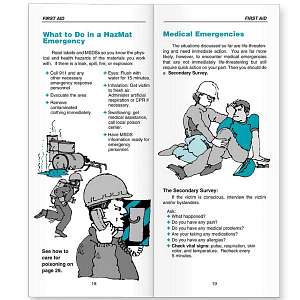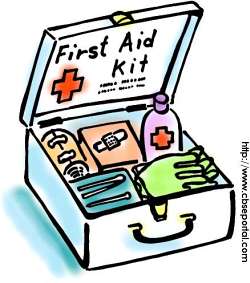(Project) School project on "Pocket Guide on First Aid"
Disclaimer: This website is NOT associated with CBSE, for official website of CBSE visit - www.cbse.gov.in
School project on "Pocket Guide on First Aid"
The First Aid pocket guide should contain aid that needs to be given for fractures, poisoning, cuts and burns, heat and cold wave and other threats that are prevalent in that area. The content shared in the guide should be supported with adequate pictures so as to give a clear and elaborate understanding about the topic. Choose awareness campaign strategy for either senior citizens or illiterate people and prepare a brief write-up.
You need to first arrange it, first the cover page should have a red cross, then it should have an index ( it is necessary) the cover page can be of light blue colour with a red crosses box picture.You can use the red red cross pictures that we have posted in the end of this artcile.
It should include “DRABCD” :
- Danger
- Response
- Airway
- Breathing
- Compressions/Circulation
- Dephibrilation
Below is the list of supplies you should have in your First Aid :
- Plastic bandages
- Transpore tape
- Alcohol preps
- Adhesive bandages
- Micropore tape
- Gauze
- Extra large plastic
- bandages
- Iodine prep pads
- Fingertip bandages
- Sterile pads
- Antiseptic towelettes
- Knuckle bandages
- Antiseptic ointment
- Ammonia inhalant
- Sponge packs
- Instant ice packs
- Sterile eye wash
- Elastic bandages
- Eye pads
- Safety pins
- First aid cream
- Bandage scissors
- Tweezers
- Butterfly bandages
- Water tight utility
- box for contents
- Burn gel to treat burns
- Burn bandages
- Adhesive spots
- Extra large strips
- Surgical tape
- Sponges
- Pain reliever
What is the aim of First Aid ?
The key aims of first aid can be summarized in three key points:
- Preserve life is the overriding aim of all medical care, including first aid, is to save lives
- Prevent further harm also sometimes called preventing the condition worsening, this covers both external factors, such as moving a patient away from a cause of harm, and applyingfirst aid techniques to prevent worsening of the condition, such as applying pressure to stop a bleed becoming dangerous.
- Promote recovery - first aid also involves trying to start the recovery process from the illness or injury, and in some cases might involve completing a treatment, such as in the case of applying a plaster to a small wound.
- First aid training often also incorporates the prevention of initial injury and responder safety, as well as the treatment phases.
When First Aid is Required ?
- Altitude sickness, which can begin in susceptible people at altitudes as low as 5,000 feet, can cause potentially fatal swelling of the brain or lungs.
- Anaphylaxis, a life-threatening condition in which the airway can become constricted and the patient may go into shock. The reaction can be caused by a systemic allergic reaction to allergens such as insect bites or peanuts. Anaphylaxis is initially treated with injection of epinephrine.
- Battlefield First aid – This protocol refers to treating shrapnel, gunshot wounds, burns, bone fractures, etc. as seen either in the ‘traditional’ battlefield setting or in an area subject to damage by large scale weaponry, such as a bomb blast or other terrorist activity.
- Bone fracture, a break in a bone initially treated by stabilizing the fracture with a splint.
- Burns, which can result in damage to tissues and loss of body fluids through the burn site.
- Choking, blockage of the airway which can quickly result in death due to lack of oxygen if the patient’s trachea is not cleared, for example by the Heimlich Maneuver.
- Childbirth.
- Cramps in muscles due to lactic acid build up caused either by inadequate oxygenation of muscle or lack of water or salt.
- Joint dislocation.
- Diving disorders resulting from too much pressure.
- Near drowning or asphyxiation.
- Gastrointestinal bleeding.
- Gender-specific conditions, such as dysmenorrhea and testicular torsion.
- Heart attack, or inadequate blood flow to the blood vessels supplying the heart muscle.
- Heat stroke, also known as sunstroke or hyperthermia, which tends to
occur during heavy
exercise in high humidity, or with inadequate water, though it may occur spontaneously in some chronically ill persons. Sunstroke, especially when the victim has been unconscious, often causes major damage to body systems such as brain, kidney, liver, gastric tract. Unconsciousness for more than two hours usually leads to permanent disability. Emergency treatment involves rapid cooling of the patient. - Heat syncope, another stage in the same process as heat stroke, occurs
under similar conditions as heat stroke and is not distinguished from the
latter by some authorities.
Heavy bleeding, treated by applying pressure (manually and later with a pressure bandage) to the wound site and elevating the limb if possible. - Hyperglycemia, or diabetic coma.
- Hypoglycemia, or insulin shock.
- Hypothermia, or Exposure, occurs when a person’s core body temperature falls below 33.7°C (92.6°F). First aid for a mildly hypothermic patient includes rewarming, but rewarming a severely hypothermic person could result in a fatal arrhythmia, an irregular heart rhythm.
- Insect and animal bites and stings.
- Muscle strain.
- Poisoning, which can occur by injection, inhalation, absorption, or ingestion.
- Seizures, or a malfunction in the electrical activity in the brain.
Three types of seizures include a
grand mal (which usually features convulsions as well as temporary respiratory abnormalities, change in skin complexion, etc) and petit mal (which usually features twitching, rapid blinking, and/or fidgeting as well as altered consciousness and temporary respiratory abnormalities). - Sprain, a temporary dislocation of a joint that immediately reduces automatically but may result in ligament damage.
- Stroke, a temporary loss of blood supply to the brain.
- Sucking chest wound, a life threatening hole in the chest which can cause the chest cavity to fill with air and prevent the lung from filling, treated by covering with an occlusive dressing to let air out but not in.
- Toothache, which can result in severe pain and loss of the tooth but is rarely life threatening, unless over time the infection spreads into the bone of the jaw and starts osteomyelitis.
- Wounds and bleeding, including laceration, incision and abrasion, and avulsion.

Be prepared 24/7 for a medical emergency.
Whether you’re at home, on the road, or in the woods, Jive Media’s Pocket First Aid & CPR Guide is at your fingertips with concise, clear instructions to care for you and your loved ones.
Dozens of articles, including CPR, the Heimlich Maneuver, bites, bruises, burns, seizures, diabetic emergencies, and many more. All articles are stored on your iPhone, so you can providefirst aid even when out of cell phone range.
Enter your medical information on the My Info tab. Save your doctor’s contact information along with your hospital, emergency contacts, allergies, and medications. You can also save your insurance information for quick access.
First aid can and does save lives. Be as prepared as possible!
Features:
– Articles are grouped by category for quick access
– First aid instructions are available even when out of cell-phone range. Perfect for wilderness outings.
– Linked articles, for quick access
– First aid kit information
– Save you medical information for quick retrieval. Look up your doctor or emergency contacts with a single click.
– Store your insurance information in an easy-to-access location.
You surely got a paper guiding you to the other projects of which one of them was first aid guide no ? if not then here it is
Prepare a pocket guide on First Aid for your school. The First Aid pocket guide should contain aid that needs to be given for fractures, poisoning, cuts and burns, heat and cold wave and other threats that are prevalent in that area. The content shared in the guide should be supported with adequate pictures so as to give a clear and elaborate understanding about the topic. Choose awarenesscampaign strategy for either senior citizens or illiterate people and prepare a brief write-up.
Note for the Teachers: The project can be carried out by a group of students in a class and work can be equally divided amongst the students so that the teachers are able to evaluate them easily. Doctors, local health practitioners, trained volunteers of Red Cross and professionals from other agencies/bodies/institutes, proficient in this field can be consulted to prepare the first-aid pocket guide . This guide can be printed by the school administration and shared with all the students, teachers and other staff members of the school. It can be used as a ready reckoner for anyFirst Aid related information.
